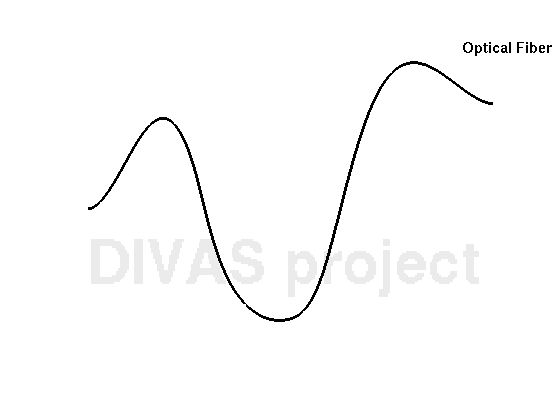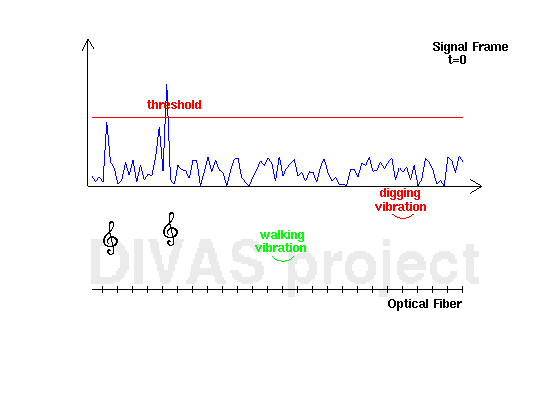


DIVAS project Introduction
Light is largely used to investigate mediums using several basic principles, such as a driver uses car headlights to
obtain information of the track in the darkness. In the same way, light is used for monitoring and maintaining the
leading communication medium, the optical fiber. For example, an infrared light pulse is used to measure fiber
losses through backscattering phenomena (the way commercial OTDR –Optical Time Domain Reflectometer–
works) or to evaluate temperature and strain stress along the fiber through Brillouin phenomena.
The project DIVAS (DIstributed Vibrational and Acoustic Sensing technology) focus on turning the optical
fiber in a Distributed, point resolved, Acoustic Sensor (DAS) through the Phase-OTDR (i.e., Phase-sensitive
OTDR or Coherent-OTDR) principle. Phase-OTDR uses a highly coherent pulse of light that turns each infinitesimal element of the
optical fiber, through backscattering phenomena, into an interferometric device that provides an incredible
sensitivity to vibrations. The high level of sensitivity makes this kind of sensor capable of the detection of very low
amplitude acoustic and ultrasonic vibrations, which is useful for the detection of seismic events and structural
health monitoring.
The sensed fiber optic line acts as an indefinitely long and
extremely sensitive distributed microphone with a very wide bandwidth.

Each infinitesimal interferometric element contributes to the creation of an interferometric signal whose amplitude variation is proportional to the change of
stress (or temperature) in the corresponding point of the optical fiber. The change of stress occurs due to the
vibrations that reach the fiber. Even though these changes in the fiber stress are very small, the
distributed interferometric sensor provides such a high gain, that it maintains a linear stress response only at very
low vibration levels. Therefore, special computations are required to retrieve, if needed, complete information of
the fiber stress and temperature. This feature is not a limitation of this technology because its extreme sensitivity, without any additional elaboration, it
grants a spectrum analysis along the entire fiber optic line and therefore allows spectral footprint recognition of
events by revealing specific frequencies (e.g. resonance frequencies in SHM -Structural Health Monitoring-).
On the other hand the possibility of linear strain measure enable the device to increase knowledge of the structure monitored. E.g. measuring the strain of a fiber attached to a rail of a high speed line it is possible to obtain the dynamic load (weight-in-motion) of a train running over 300 km/h or to determine the pressure and fluid flow in a pipeline with a non-intrusive measurement.
Project Information
Project Duration
The project DIVAS formally started in 06/06/2016 and it will progress during 24 months.
Researchers
Experienced Researcher: Massimo Leonardo Filograno.
NHRF Supervisor: Maria Kandyla.
Active Partners
National Technical University of Athens (Professor Charis Gantes).
Phase-OTDR
A Phase-ODTR (Phase-Optical Time Domain Reflectometer) introduces a extremely coherent light pulse in the Optical Fiber Under Test (OFUT) and analize the backscattered light retrieved back. This kind of elastic scattering partially maintains the characteristics of the input pulse, therefore all the light that move back is coherent and interfiere generating a specific pattern as result of the superposition of several coherent backscattered signals that depend on source phase, source coherence, source amplitude and the local refractive index changes of the fiber. The retrieved signal (the simple backscattered optical power intensity collected by a photodiode) has a noisy appearence and changes according to the stress/temperature applied to the OFUT (Optical Fiber Under Test).

As shown in the animation, any vibration applied to the OFUT generates a modification of the pattern of the retrieved interfering signal. Even though these changes in the fiber stress are very small, the distributed interferometric sensor provides a high gain that maintains a linear stress response only at very low vibration levels. Non-linearity appears, in the raw signal, for high magnitude vibrations. A Phase-ODTR has the potenciality to retrive correctly sound, music, and to detect vibrations and recognize, throught frequency patterns, vibration sources.
Applications
The possible Phase-ODTR applications are numberless, the technology versability allow its use in application where rigourous strain measure is desired e.g. High-Speed Raylway (train localization, train identification, speed/velocity calculation, weight in motion estimation, security and real time monitoring), Structural Health Monitoring (displacement, stress and vibration measurement), fluid flow in a pipeline with a non-intrusive measurement; but also where a vibration revelation is enough e.g. civil and military security (intruder detection, listeing and identification), siesmic application (frequency pattern recognition), structural health monitoring (through the resonance frequency analysis), electric cable temperature monitoring (ignition prevention), etc..
The main objective of the DIVAS project is bringing a mature technology to the applied research and to the industrial explotaton throught providing a ready, versatil and low-cost Phase-OTDR setup to the market ready to to be assembled in mass production.
Contact
We are looking for partners and organizations interested in this project and aimed to satisfy the market that could bring the technology to the applied research.
For any inquiry inherent to the project or for a partner collaboration proposal please contact Massimo L. Filograno
([email protected]) or Maria Kandyla ([email protected])